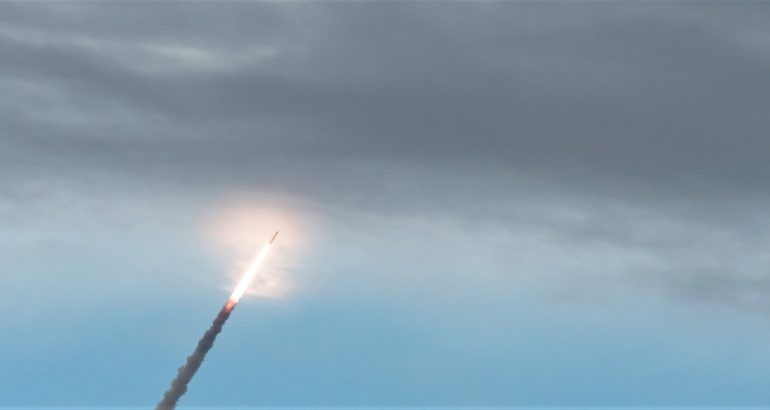The firing took place off Britany in Western France. The M51 SLBM was tracked throughout its flight phase by radars and by the missile range instrumentation ship Monge (A601). The fallout zone was located in the North Atlantic several hundred of kilometers from any coast.
According to an official statement: This test was carried out without nuclear warhead and in strict compliance with France’s international commitments. This firing validates the operational capacity of the SSBN Le Téméraire’s global weapon system and once again demonstrates the high-tech excellence that French industries are implementing in this area.
The fallout zones for the M51 missile, launched today from the Le Téméraire submarine in Audierne Bay. The range on the ground is less than 6000 km. The impact zone is 650 km from the coasts of Puerto Rico and the Dominican Republic. Note that a Dassault Falcon 50MS (FNY5015) from the French Navy and a RC-135S (ZIGGY11) from the US Air Force patrolled near the impact area at the time of the test.
Bravo Zulu to all the sailors of FOST, the strategic oceanic force, and to the wider circle of sailors of all forces, who directly contributed to this success!
Chief of Staff of the French Navy, Admiral Prazuck
Earlier this week, French ship spotters saw the SSBN heading out at sea fitted with telemetry masts. According to our information, the forward mast (on the submarine’s sail) is used to measure or observe the missile once it is out of the water. Things like: how the missile breaks the water surface, how and when the engines kick in etc. The aft mast is used to measure and observe things happening underwater (such as the SLBM exiting the silo):
Le Téméraire is the second ship of a class of four SSBNs but is the final submarine of its class to get the M51 SLBM upgrade. It was previously fitted with the older generation of missile: the M45. Le Téméraire came out of an extensive mid-life upgrade by Naval Group in 2018.

The M51 SLBM is now fitted aboard all SSBNs of the French Navy.
About the Triomphant-class SSBN

The Le Triomphant-class is a class of four nuclear-powered ballistic missile submarines (SSBN) of the French Navy built by DCNS (now known as Naval group). They are known in French as Sous-Marin Nucléaire Lanceur d’Engins de Nouvelle Génération – SNLE NG. They replaced the Le Redoutable-class from 1997. They were commissioned in 1997, 1999, 2004 and 2010.
These submarines are fitted with 16 submarine-launched ballistic missile launching tubes each and are equipped with M51 ballistic missiles but also traditional armament such as torpedoes and anti-ship missiles, Exocet. Le Terrible, last ship of the class which was commissioned in 2010, was fitted with M51 capability from its construction. The other three SSBNs originally deployed M45 missiles and were upgraded for the new M51 missile by DCNS
Triomphant-class SSBNs are dedicated to the French nuclear deterrent mission. As such, at least one of the SSBN is always deployed at sea. The fleet of 4 SSBNs ensures that 3 can be maintained in the operational cycle and continuously guarantee there is at least one SSBN at sea during peacetime.
Le Triomphant-class main specifications:
Displacement: 12 640 tonnes surfaced; 14 200 tonnes submerged
Length: 138 m
Beam: 12.5 m
Depth: <300 m
Propulsion: nuclear reactor K15, turboreductor system, two diesel-powered generators SEMT Pielstick auxiliaries
Nuclear weapons: 16 ballistic missiles M51
Traditional weapons: four 533 mm torpedo tubes for F17 torpedoes and Exocet SM39 anti-ship missiles
Crew : 110
About M51 SLBM

The M51 is the new generation intercontinental SLBM which started replacing the M45 in 2010. Each missile carries six to ten independently targetable (MIRV or Multiple Independently targeted Reentry Vehicle) TN 75 thermonuclear warheads. TN 75 are being replaced with the new Tête nucléaire océanique (TNO or oceanic nuclear warhead) warheads since 2015. These new warheads are reported to be maneuverable (MARV or Maneuverable Re-entry Vehicle) in order to avoid potential ballistic defenses. The TNO has a yield that is estimated to be greater than or equal to the yield of the TN 75 warhead, 150 kilotons of TNT (kt) with a CEP (circular error probability) of 150 meters.

The three-stage engine of the M51 is directly derived from the solid propellant boosters of the European Ariane 5 space rocket. Open source data indicates an M51 weight of 52,000 kg, a length of 12.0 m and a diameter of 2.3 m. M51 operational range is reported to be 8,000 to 10,000 km with a speed of Mach 25.
The first test launch of an M51 ballistic missile was successfully carried out at Centre d’essais de lancement de missiles (CELM) in Biscarosse, France, on November 9, 2006. The sixth missile test carried out on May 5, 2013, ended in failure. The latest M51 tests in September 2015, July 2016 and June 2020 were all successful.






